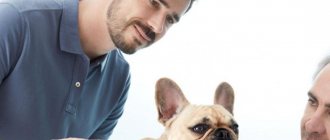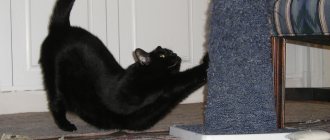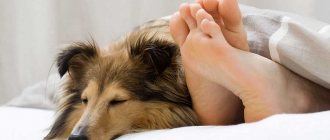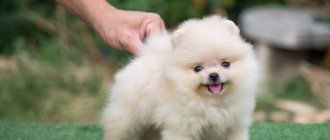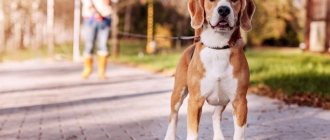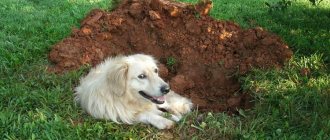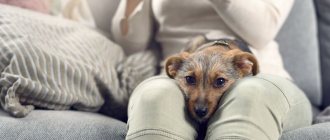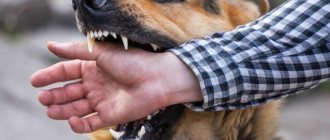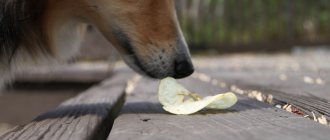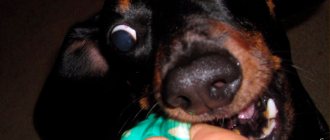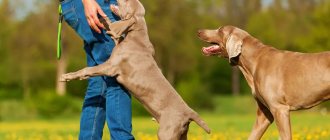Why does a dog chew furniture?
There are several reasons for this behavioral problem. Animal psychologists are unanimous in their opinion that the main reason that a dog chews furniture is lack of attention from the owner . The pet tries to attract and evoke emotions in its owner, no matter whether positive or negative.
Hunter's Instinct
Dogs descended from wolves.
The instinct to tear prey lives in them to this day. A domestic dog spoils furniture, guided by the instinct of a hunter, as if tormenting a caught animal.
Changing teeth
In the period from 3 to 7 months, the puppy chews everything it sees. A small animal's gums itch, so it gets rid of annoying itching and helps the molars erupt outward.
A small puppy is given toys, diverting his attention from surrounding objects.
Oral problems
Adult dogs test furniture if they have sore gums or teeth. Tartar and bone damage cause discomfort. By chewing wooden objects, the animal gets rid of pain or itching.
If your dog has bleeding gums and puts his paw into his mouth, you should consult a veterinarian.
Loneliness
When a dog is often left at home alone, bored, he chatters all around. She is not interested in boring toys; the animal wants to try the unknown in the absence of the owner.
Low physical activity
For active young animals, a morning or evening walk is not enough. The owners let them go do their business, run, play, but skip training. After a walk, the energy remains, the dog directs it to deal with the furniture, other things suffer.
Children's habit
The puppy’s harmful actions are stopped immediately.
If this is not done, the habit will take root and an adult animal will be more difficult to train.
Stress
Small breeds of dogs are companions (Chihuahua, Toy Poodle, French Bulldog).
They cannot spend most of the day alone. This causes them stress and a feeling of loneliness. When distracted, the dog damages furniture, wallpaper, and shoes.
Violation of the regime
The dog should have a set daily routine.
The dog gets up and goes to bed at the same time, he must know when the owner will leave and come, then his absence will not cause stress.
Poor nutrition, vitamin deficiency
A poor diet leads to disorders, vitamin deficiencies, and decreased immunity. Oral diseases may develop. The dog looks for missing trace elements everywhere, testing surrounding objects.
Why does a puppy chew furniture?
Let's learn about the reasons that encourage puppies to chew furniture.
A way of understanding the world around us
Lack of physical activity
Errors in education
Often the dog owners themselves are to blame for the fact that there is no furniture left in the house. They indulged the puppy when he tried the legs of the sofa or table. By not stopping his attempts to chew furniture, they thereby encouraged his bad habit. It’s just that if a several-month-old puppy’s teeth are small and not too sharp, then a teenage dog’s teeth are strong. And the damage he causes to furniture with them is much greater.
If you do not want your dog to chew furniture, immediately, from the first day of its appearance in your home, stop such attempts. If the animal understands the commands, you can say “Ugh”, “No”. If the commands are not yet familiar to him, let the animal understand that this is not possible.
How to stop a puppy from chewing furniture
When you take a puppy into your home, you need to agree that all family members take part in its upbringing. At the same time, in order to wean oneself from bad habits, everyone must say the same word: “Ugh!” or “You can’t!” This way the baby will quickly understand the rules of behavior in the house.
Natural curiosity pushes the puppy to chew not only upholstered furniture, but also everything that comes into its field of vision. Therefore, the owner must put small or fragile objects, medicines, and hide wires out of reach. Store shoes on shelves with doors, and outerwear in closets. Wrap the legs of chairs, armchairs, and corners of wooden furniture with cellophane.
Make a spacious enclosure for the puppy, in which you will place it while all family members leave home. To prevent the puppy from getting bored, leave toys, water, and bedding there for sleeping.
How to stop a dog from chewing things?
So, let's begin. Firstly, you definitely need to keep an eye on the puppy and someone from the household should always be with him when he moves freely around the apartment. When he is under close supervision, it is unlikely that he will commit any global offense.
We suggest you read: Starter feed for piglets - pig breeder's guide
Also, an important factor is the availability of toys for your puppy, and in sufficient quantities, otherwise, when he finishes with them, it will be the turn of your interior. All these factors at the initial stage of raising a dog will provide the basics for the formation of its future behavior.
How to correct the behavior of an adult dog
Dog handlers advise not to punish a pet for an offense that has already been committed. But when gnawing is detected, it is necessary to immediately begin working on the mistakes.
As a punishment for an adult dog, you can use the commands “Ugh!”, “You can’t!”, and then “Lie down!” or “Sit!”
That is, the guilty dog must remain in a motionless position for a long time (several minutes). Next, the owner needs to ignore the pet (about one hour). The lack of human attention and affection is hard for the animal, and it learns its lesson.
If the owner cannot stop the dog from chewing furniture on his own, he must seek help from a dog handler. There are courses in which a specialist tells what to do if a puppy chews furniture legs and other things. He explains the psychology of pets and teaches how to build proper communication with animals. During practical training, the dog learns commands.
Weaning a dog is easy
Owners, faced with damage to their own property, begin to think about how to stop their dog from chewing furniture. There are several ways:
- use of a prohibiting command, negative reinforcement;
- ignoring a pet;
- switching (distraction);
- protecting furniture with special sprays or unpalatable food.
Using the Deny Command
When thinking about how to protect furniture from a dog or puppy, someone resorts to swearing and mechanical pressure on the animal. And others - to the braking team.
The second option - the prohibiting command - is used when the dog is caught at the scene of a crime. In three seconds, the dog will forget what he did and will not understand why the owner gives the braking command.
If a dog chews on a sofa, chair leg or other furniture, the owner should take the following measures:
- Approach your pet.
- Say the command “no”, “no” or “fu” in a stern voice.
- Use negative reinforcement. To do this, you need to take the dog by the withers, lift it a little and shake it. Negative reinforcement is not suitable for puppies; an inhibitory command is enough for them.
Important! Everything must be on time, and so should the braking team. It is useless to give it or scold your pet for an offense several hours after the incident.
Ignoring
After prohibiting unwanted actions, the dog will want to communicate with the owner. The latter’s task is to ignore the dog when he offers to play or wants to cuddle. You can do this silently or use an inhibitory command and send the pet to its place.
After a couple of minutes, the owner should call the dog and offer it a game himself.
Switching (distraction)
Another answer to the question of how to stop a puppy from chewing furniture is switching or distraction. The method is also suitable for young dogs. Distraction with a treat or toy is used depending on the pet’s preferences.
As soon as the dog starts chewing the furniture, the owner calls him over and starts playing. The owner’s task is to convey to the pet that being next to the owner is much more interesting than having a sofa or walls.
If the pet is not motivated to play with a toy, a treat is used. The principle of operation is the same, first you need to call your pet, then say several commands from the complex (“sit”, “lie down”, “stand”), reinforce the action with a treat and praise.
Important! This weaning method is ideal for puppies and young dogs. An adult animal whose chewing on furniture has become a habit needs other methods of behavior correction.
Switching the dog to the ball was successful, he is busy playing
Using sprays or unpalatable foods
A special spray to prevent dogs from chewing furniture is suitable for both adults and puppies. For the latter, a drug with an appropriate mark on the label is selected.
It is important to understand that high-quality sprays are expensive, but they give effect. Anti-gnaw agent is sprayed onto furniture and walls and allowed to dry. The dog is repelled by the smell; after trying to get closer to the sofa, armchair or other furniture a couple of times, the dog will stop trying.
On a note! The duration of weaning using a spray ranges from two days to a week. It all depends on the dog’s persistence.
It’s not always possible to buy a spray, then what should you use to prevent your dog from chewing the furniture? For example, mustard, horseradish or hot pepper. They are used to treat walls and areas of furniture that the dog likes.
Anti-chew spray
Important rules to follow
There are a number of rules that will help correct your pet’s behavior and eliminate possible bad habits.
Physical exercise
It is very important to keep your dog physically occupied. This means not just a walk, but active games in the fresh air. You need to let the dog play and run around to its heart's content. An animal that is tired from a walk is more likely to sleep and will simply not have time to chew furniture.
After a walk, it is necessary to feed the dog well, because it is known that on a full stomach animals do not feel much excitement and anxiety, so they will not try to keep themselves busy.
Treats for chewing
You can keep your dog busy by leaving him his favorite treat. Special cartilage, pig ears, and beef tracheas are excellent for this. It is important to leave your favorite treat in its entirety so that the dog cannot finish it in one go.
Note! Various treats, chosen correctly, are necessary for the normal growth and development of a young dog. Such delicacies are cartilage, which not only helps strengthen the body, but helps prevent the appearance of plaque.
Help from a dog handler
In some cases, the dog does not want to obey the owner and continues to chew furniture during his absence. Experts recommend taking full courses on behavior correction and pet obedience.
Protective sprays
Pet stores sell products to stop dogs from chewing furniture.
Knabber Stopp
Trixie has made a spray for puppies and dogs in a convenient plastic bottle with a spray nozzle. The liquid does not smell at all, but has a strong unpleasant taste. The bitterness is created from safe plant extracts, so the product can be sprayed even near outdoor pots with indoor plants.
Dog chewing protection
The Russian company Api San has released a series of “Smart Sprays”. One of them – “Protection against chewing dogs” – has a slight orange smell and a pronounced bitter taste. It contains red pepper extract, isopropyl alcohol, and essential citrus oils.
After contact with objects treated with the spray, the pet experiences a burning sensation on the tongue and increased salivation.
Mr Fresh
The Russian company Ecoprom, together with the German company Veterinar Bio, has produced a spray “Protection against chewing for dogs.” The main component in the composition is wormwood extract, and additional components are purified water, alcohol, and fragrances. The product is used to treat furniture legs, wires, and shoes. It does not leave streaks, but is incredibly bitter, which scares away curious pets.
Folk remedies
Some dog owners apply herbal infusions with a bitter taste to certain surfaces. The dog quickly understands that it is not worth chewing on objects with a composition that leaves a bitter taste in the mouth.
The method is not very effective; besides, furniture and shoes should not be wetted with a solution that emits a specific odor. This processing method is suitable for rooms that have old sideboards, cabinets, and beds with headboards, which the owner plans to replace later. Wires and moisture are incompatible things.
Another, safer option for folk remedies: apply a little grapefruit or orange essential oil to the furniture. Pleasant for people, but strong enough for dogs, the smell will keep your pet away from areas that are most likely to suffer from dental damage.
A more effective and reliable method described in the next section will help to wean an animal from gnawing things in the absence of the owner.
Restricting your dog's access to certain areas of the house
If the owner has tried various methods on how to stop a dog from chewing furniture, but his pet continues to do it, then the only 100% way to prevent such unwanted behavior is to keep the dog away from certain places in the house, for example, always close the doors to the room where the furniture is. . If the owner has resorted to this method of solving the problem, then you need to know that leaving the dog alone for a long time closed in a small room is not recommended, as this will provoke a feeling of melancholy in the pet or increase stress, which will further aggravate the problem.
Useful tips
- When it comes to a puppy, you need to remove valuables from his sight. Shoes should be in the closet, children's toys in drawers. It is important to ensure that all doors are closed. The corners of the sofa are wrapped in a plastic bag. These actions are necessary until the baby loses interest in chewing. You can close several rooms in the apartment. Some owners temporarily leave their pets in a spacious playpen. For example, when there are no people at home.
- Show things that are permissible to chew. If an animal encroaches on the chair, it is important to clearly say “No”. Then you should give him a bone or a toy and praise him when he starts chewing it. Thus, his attention is switched. It is important not to scare your pet and speak calmly.
- Involve all family members in the educational process. Each person in the house should keep things in their place, away from the dog's toys. You need to choose a single method of punishment and commands so that everyone adheres to them. Different educational techniques will confuse the animal.
- Prohibit biting people. The pet must take the owner's words seriously. When he encroaches on skin or clothing, you need to suddenly pull him back and scold him. Then you need to stop the game and start ignoring the dog. Turn away from her, avoid eye contact. When your pet calms down, you can continue working together. He will soon understand that people do not approve of bites, and he feels bad after them.
- Hide legs, armrests and corners of furniture. These areas are considered the most vulnerable.
- Keep toys within your pet's sight. If the dog is not interested in them, you can play together “fight for things” or give the command “fetch”.
- Give your pet attention. It is important to constantly find activities and teach new things. Affection and shared communication are also necessary. Then the dog will not have time for pampering.
- Leave the radio or TV. Because of this, the pet will feel less lonely. Don't forget to hide the wires.
Where to start when trying to stop your dog from ruining things?
Regardless of the pet’s age, only the pet’s strict execution of the “Fu” command can guarantee the “long life” of furniture and other items. Therefore, it is necessary to learn it as quickly as possible.
Any unwanted action of a dog must be stopped at the moment it is committed, and not after a few minutes or even hours, when the owner sees the result of the dog’s “creativity.” If we catch a puppy “eating” a chair leg or chewing a slipper, we pronounce the command “Ugh” in a rude voice and sharply grab the pet by the withers or neck from above. We imitate the attack of an adult dog. You need to grab the skin with your fingers and shake slightly. As soon as the puppy stops the unwanted actions, we immediately praise and distract with a toy.
